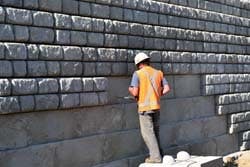Rock Solid
In a planned community like Emerald Hills, storm water management not only has to function well—it has to look good, too. So when engineers and architects were challenged with creating an aesthetic solution for a roadway that bisected two retention ponds at one corner of the development, they had to get creative.
Emerald Hills is a mixed-used residential and commercial community located on a high visibility stretch of the Yellowhead Highway, a main artery through the Edmonton, Alberta, Canada, area. Because this corner of the development is visible from the highway, creating an aesthetic finish for
the roadway and retention ponds was important.
“For this project, scheduling was essential and we needed to install all the underground infrastructure in 2010, then put the road on, then put the walls in afterward [in 2011]. For walls the height we needed, most wall systems would have required tiebacks, which would have disturbed the utilities,” explained Alex Swonek, P.E., of Select Engineering Consultants.
Finding a Solution
“Construction timing led us to choose Redi-Rock. Because it didn’t require tiebacks, we were able to install the blocks after everything else went in, [which solved] our construction timing issue,” Swonek said.
The massive size of each block (weighing in at 2,351 lb each, as much as a Budweiser Clydesdale) allows tall gravity walls to be built without geogrid or tiebacks. Gravity construction also allows walls to be built without disturbing utilities and infrastructure in many applications—
making the blocks a good fit for projects in confined spaces like Emerald Hills. This project required
a 13.5-ft wall on both sides of the roadway, which Redi-Rock was able to handle.
The wall was constructed so that the water appears to be flowing through the arches at its base. The water actually flows though a culvert underneath the entire roadway structure and a few feet below the base of the retaining walls. The culvert regulates the water level of both retention ponds.
“Giving the appearance that the water flows beneath this bridge-like structure was more visually appealing than plain retaining walls,” Swonek said.
On top of the 13.5-ft gravity walls, short parapet walls were topped with cap blocks. In addition, Redi-Rock column blocks were integrated with wrought iron fencing to create an aesthetic finish and to act as a guard rail for pedestrian traffic.
Other design decisions included choosing a texture. “We chose the Cobblestone texture, which gave us a look that went with the neighborhood,” Swonek said.
“We ultimately [decided to use] the natural gray color because it’s more of a timeless look,” added Brad Giesbrecht, landscape architect with Browning Horrocks Design Inc. The arch block pieces and the cap blocks were a darker gray color, giving the entire project a two-tone look.
The Installation
Jim Kapteyn of Rockwater Landscapes Ltd. led the installation of the project.
“We’ve installed a number of large projects in the Edmonton area, and I like that I can use a very small crew to do a very large project. The sheer volume of the block itself allows us to build walls without reinforcement, which allows us to be more efficient,” Kapteyn said.
Swonek added, “It’s easy to use and installs way quicker than any other retaining wall system. The tiebacks and the amount of excavation is way less, and it’s a lot more stable against any sort of water body when you have ice forming against it.” Armor stone was also specified at the base of the walls to protect the base blocks from ice damage.
“It took us about 20 days to get the walls up, then it took another 20 days to do all the detail work,” Kapteyn said. From start to finish, the project took a total of six weeks to install.
The major component of that detail work was installing the archways. To allow for the construction of the archways, “we worked very closely with Westcon Precast [the local Redi-Rock manufacturer] to create custom blocks with a smooth finish that made the arch design possible without sacrificing the structural integrity, which allowed us to achieve the look that we did,” Giesbrecht said.
The advantage of using a precast system for this project was that the designers were able to create a structure that used both Cobblestone texture blocks and custom smooth-textured blocks that required no cutting on site, resulting in a cleaner look and faster installation time. These smooth blocks later were stained black to give the appearance of open culverts from a distance.
To create the keystones for the archway, Westcon Precast custom poured 4- to 5-in.-thick pieces with a similar shape and texture to the Cobblestone blocks. The crew from Rockwater Landscapes then drilled and placed rebar into the retaining wall blocks and used heavy duty concrete epoxy to attach the keystone pieces to the blocks, using a void in the back of the keystone pieces as an anchor for the rebar.
The finished result is a seamless transition between the Cobblestone-textured blocks and the smooth-textured blocks, and a believable illusion of an open culvert. Throughout the year, the water level will fluctuate and often be higher than the base of the arches, adding to the illusion that water flows through the archways.
The Outcome
In total, the project required 3,700 sq ft of blocks. The identical walls on either side of the roadway stand 13.5 ft tall at the highest point, plus an additional 4.5 ft comprising the parapet walls and the column blocks.
“We’re going to be using [this product] throughout the neighborhood,” Swonek said.
“Based on cost and efficiency of installation and overall aesthetics, I think the client was quite pleased. We’re all quite happy with the way it turned out,” Giesbrecht said
Download: Here


